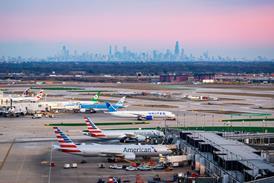From its spa to its squash courts, sleeping lounges and swimming pool, Hamad International’s range of amenities is such that Qatar Airways chief executive Akbar Al Baker is emboldened to say of the new Doha hub: “I don’t think there is any airport of this standard anywhere in the world.”
When Qatar Airways – which operates the new airport – confirmed May 27 as the date for its move there, it signalled the end of a two-year delay. A “very disappointed” Al Baker puts the associated opportunity costs to the airline at $650 million per annum.
While Qatar Airways’ own premium lounges at the hub are still a couple of months from completion, there was no delaying it any further. “If you would have again delayed the opening even by two months, we would take another hit of $150 million, which we cannot afford,” says Al Baker. “And we cannot delay our A380 deliveries any more. So this made us do it. And we realised something: that unless you push people into the deep end they will not learn to swim. So we had to do it, and people have to manage.”
Al Baker attributes the delay to the opening of Qatar Airways’ first- and business-class lounges to the contractor “having difficulty keeping up with the kind of finishes we want”, and cites “complicated”, “high-end” specifications. For the interim between the move to the airport and the opening of the lounges, the airline has made plans to accommodate affected passengers in other lounges at the airport – or, if capacity is constrained, to issue them with vouchers providing “good value”.
The Qatari flag carrier’s move to HIA was preceded by a “soft opening” on 30 April. Among the airlines to have operated during this initial phase are Air Arabia, Air India Express, Biman Bangladesh Airlines, Flydubai, Iran Air, Nepal Airlines, Pakistan International Airlines, Pegasus Airlines, Syrian Arab Airlines and Yemenia.
Located 4km from Qatar’s former main base at Doha International, the new airport was built on land of which 60% was reclaimed from the sea. It offers an initial annual capacity of 30 million passengers, and this will rise to 50 million once concourses D and E join A, B and C in operation, as will happen by 2017. Foster & Partners, founded by Norman Foster, has been contracted for concourses D and E.
There are 41 contact gates at the airport, and this will rise to 65 in line with the expansion. Six gates are designated to the Airbus A380, imminently to enter service with Qatar Airways.
Among the airport’s 138 check-in counters are 14 seated ones for Qatar Airways’ first-class passengers and 16 for the carrier’s business-class travellers. The other 108 are for those in economy class or flying with other airlines.
The 600,000m2 terminal complex includes a couple of 100-room hotels, a catering unit with capacity to serve a quarter of a million meals per day, and what Qatar Airways terms “high-end retail and food and beverage outlets” plus “activity nodes, which include computers with internet access, children’s play and rest areas”. The duty-free area is intended to have the feel of a shopping mall. “It’s not like duty free in other airports where it’s all strewn around the concourse,” says Al Baker.
And that is not the only area in which efforts have been made to distinguish the airport from others. “I’m sure you have seen in Dubai people are sleeping all in the concourses,” says Al Baker. “Here, this will not be allowed and we have proper sleeping areas for people.”
For Qatar Airways in its guise as airport operator, HIA presents far better enticement for airlines to fly to the Qatari capital, which given Doha International’s limitations “did not have world-class facilities in the past except the first- and business-class terminal of Qatar Airways”, Al Baker acknowledges. As to how HIA changes the situation, he is confidently minimal: “You will be the judge when you see the new airport.”
He’s equally confident that the new hub will be kept busy. “There is over one billion passenger shortfall in airport capacity around the world,” he says. “Keep in mind that nearly two-thirds of the world population is in Asia… If you look at just China, they have addition of 25 million [to the] middle class every year. If you look at India, their middle class is 450 million. With this in mind and shortage of airport infrastructure, we are filling in just that void that has been created.”
Source: Cirium Dashboard






















